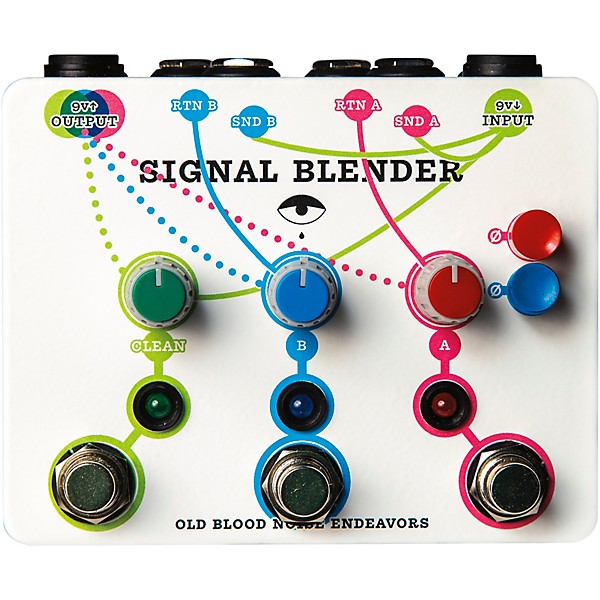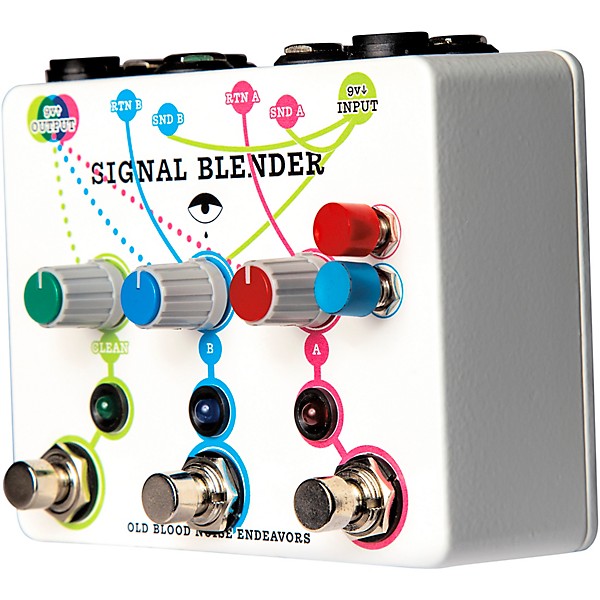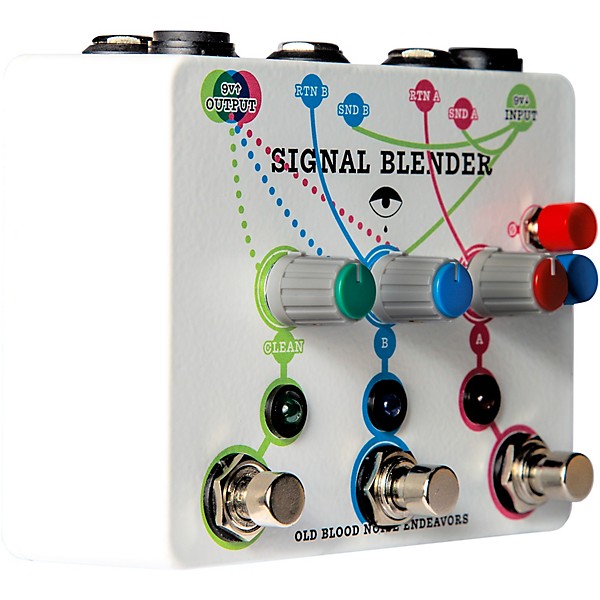TubeDigitalBoards
Guitars
Guitars
Amps & Effects
Amps & Effects
Used & Vintage
Keyboards & MIDI
Keyboards & MIDI
Drums
Drums
DJ Equipment
DJ Equipment
Basses
Basses
Recording
Recording
Live Sound
Live Sound
Accessories
Accessories
Mics & Wireless
Mics & Wireless
Music Software
Music Software
Lighting
Lighting
- Popular Brands
Band & Orchestra
Band & Orchestra
Platinum Gear
Deals
Deals
New Arrivals
Old Blood Noise Endeavors Signal Blender Switching Effects Pedal
$149.00
Need Help?
Videos (1)
View All
Dan Explains It All - Signal Blender

Description
The Old Blood Noise Endeavors Signal Blender is a box with a simple set of functions applicable in myriad ways. The main Input can go three places: Send A, Send B, and Output. Three things can go to the Output: Return A, Return B, and Input. The three volume knobs control the volume of Return A, Return B, and a boosted version of the Input (“Clean”). Three footswitches do all the routing:
Footswitch A sends Input to Send A and Return A to Output through the A volume control.
Footswitch B sends Input to Send B and Return B to Output through the B volume control.
Footswitch Clean sends Input to Output through the Clean volume control.
The Red and Blue phase switches change the phase of the signal going to Send A (red) and Send B (blue).
With all footswitches off, the Signal Blender is true bypass, with Input going straight to Output.
Parallel Effects: to use Signal Blender as a parallel effect mixer, plug Send A into the input of an effect pedal and Return A into the output of the same pedal. Repeat with Send/Return B using a different pedal. Now you can blend effects in parallel by using the footswitches, and blend in your clean signal with the Clean footswitch. If the sounds in parallel are out of phase, use the corresponding red or blue phase switch to correct it.
3-to-1 Mixing: to use Signal Blender as an instrument mixer, plug instruments into Input, Return A, and Return B. Now the A, B, and Clean footswitches send the instruments to the output and the volume can be set with the corresponding volume knobs.
1-to-3 Splitting: to use Signal Blender as a splitter, plug an instrument into Input, and plug Send A, Send B, and main Output into three amplifiers. If the amplifiers are out of phase, use the corresponding red or blue phase switch to correct it.
Clean Boost: to use Signal Blender as a volume level setter, plug Send A straight to Return A and Send B straight to Return B. In this way, every switch will add a parallel copy of the Input signal and boost the volume.
Parallel Effect and 2-to-1 Mixer: to use Signal Blender as a different sort of parallel mixer, plug Send A into the input of an effect pedal and Return A into the output of the same pedal. Plug an additional instrument into Return B. Now with all switches engaged, your output will have your first instrument, an affected version of that instrument, and a second instrument all running in parallel.
There may be some more complicated implementations of Signal Blender. By using the simple rules from the intro, you can let your mind wander and find a number of new sonic solutions.
Note: the footswitches can be latching or momentary based on how long they are held. Simply tap for latching on/off operation or hold for momentary on/off operation.
The Signal Blender uses standard 9V center negative power, and has a current draw of 31 mA. A courtesy power outlet is available in order to power an additional pedal using the same supply as Signal Blender.
Footswitch A sends Input to Send A and Return A to Output through the A volume control.
Footswitch B sends Input to Send B and Return B to Output through the B volume control.
Footswitch Clean sends Input to Output through the Clean volume control.
The Red and Blue phase switches change the phase of the signal going to Send A (red) and Send B (blue).
With all footswitches off, the Signal Blender is true bypass, with Input going straight to Output.
Parallel Effects: to use Signal Blender as a parallel effect mixer, plug Send A into the input of an effect pedal and Return A into the output of the same pedal. Repeat with Send/Return B using a different pedal. Now you can blend effects in parallel by using the footswitches, and blend in your clean signal with the Clean footswitch. If the sounds in parallel are out of phase, use the corresponding red or blue phase switch to correct it.
3-to-1 Mixing: to use Signal Blender as an instrument mixer, plug instruments into Input, Return A, and Return B. Now the A, B, and Clean footswitches send the instruments to the output and the volume can be set with the corresponding volume knobs.
1-to-3 Splitting: to use Signal Blender as a splitter, plug an instrument into Input, and plug Send A, Send B, and main Output into three amplifiers. If the amplifiers are out of phase, use the corresponding red or blue phase switch to correct it.
Clean Boost: to use Signal Blender as a volume level setter, plug Send A straight to Return A and Send B straight to Return B. In this way, every switch will add a parallel copy of the Input signal and boost the volume.
Parallel Effect and 2-to-1 Mixer: to use Signal Blender as a different sort of parallel mixer, plug Send A into the input of an effect pedal and Return A into the output of the same pedal. Plug an additional instrument into Return B. Now with all switches engaged, your output will have your first instrument, an affected version of that instrument, and a second instrument all running in parallel.
There may be some more complicated implementations of Signal Blender. By using the simple rules from the intro, you can let your mind wander and find a number of new sonic solutions.
Note: the footswitches can be latching or momentary based on how long they are held. Simply tap for latching on/off operation or hold for momentary on/off operation.
The Signal Blender uses standard 9V center negative power, and has a current draw of 31 mA. A courtesy power outlet is available in order to power an additional pedal using the same supply as Signal Blender.
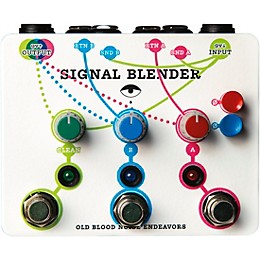
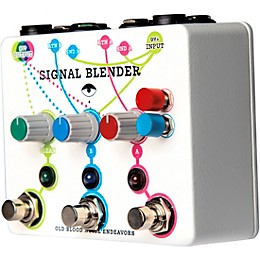
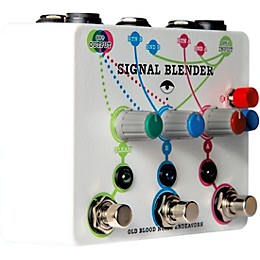
Specs
- Power requirement: 9V DC, center negative
- Draw: 31mA
- Includes pedal power output
Reviews
Be the first to review the Product
Q&A
Have a question about this product? Our expert Gear Advisers have the answers.
No results but…
You can be the first to ask a new question.
It may be Answered within 48 hours.

.jpeg)

